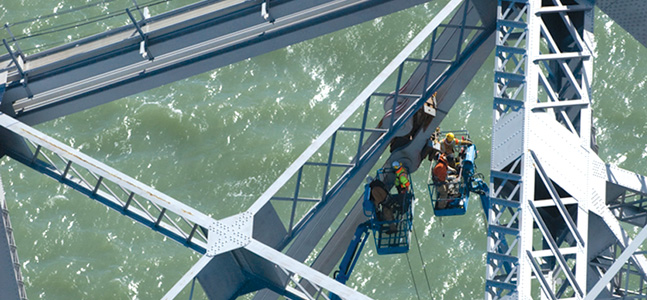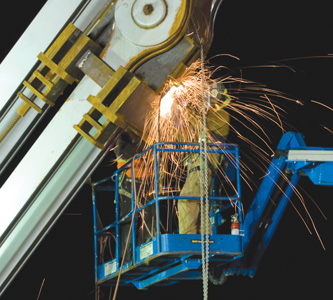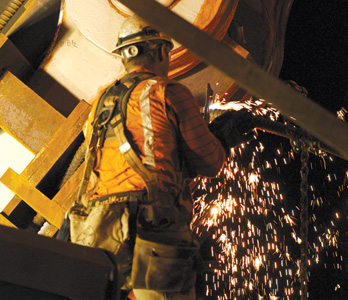Bay Area bridges have been in the spotlight this fall with a series of events that have given the region’s residents a heightened awareness of the imperative to complete the process of bringing the spans up to current earthquake standards.

Workers examine the cracked eyebar. Photo © 2009 Barrie Rokeach
More Bridge Seismic Work Ahead
By Brenda Kahn
Published: December, 2009
Bay Area bridges have been in the spotlight this fall with a series of events that have given the region’s residents a heightened awareness of the imperative to complete the process of bringing the spans up to current earthquake standards.
Taking center stage was the venerable 73-year-old San Francisco-Oakland Bay Bridge, which crossed a significant milestone this fall in the ongoing effort to replace the bridge’s East Span with a striking contemporary interpretation of a suspension bridge that is being built to withstand the “big one.” But the fall season also shined a spotlight on the Antioch and Dumbarton bridges, which are next in line for seismic upgrades.
Overseeing the work is the Toll Bridge Program Oversight Committee, made up of Caltrans, the California Transportation Commission and the Bay Area Toll Authority (BATA), a branch of the Metropolitan Transportation Commission (MTC). BATA is also financing the seismic retrofit program with bridge toll revenues.
Eyebar Defect Threatens Detour Operation
The season opened with a tricky operation in September to complete a Bay Bridge East Span detour to carry traffic to and from the Yerba Buena Island tunnel. With traffic now rerouted, the new East Span can complete its march toward the tunnel.
The daring detour operation called for a planned closure of both halves of the bridge over the long Labor Day weekend in September. The surgery to roll out a 3,200-ton double-tiered deck section the size of a football field and then slide in a 3,600-ton replacement went relatively smoothly, thanks in part to common dish soap that reportedly greased the skids upon which the massive deck sections glided.
But that monumental engineering and construction feat was soon overshadowed by the discovery of a defect — a failure in a critical steel “eyebar” member in the latticework holding up the old East Span. Eyebars are flat steel plates in the shape of a dog bone with a hole or “eye” at either end; the eyebars link together and form a chain. As a near-term solution, Caltrans prescribed a system for taking the stress off the damaged eyebar by means of steel tie rods clamped to the structure with massive steel saddles manufactured that weekend in Arizona, and airlifted to Oakland on Sunday.
While engineers were able to patch things up in time to reopen the bridge the morning after Labor Day, the eyebar repairs failed seven weeks later, in late October, prompting a reevaluation and an emergency bridge closure. Caltrans diagnosed the problem as stemming from vibrations, and developed a number of enhancements for reinforcing the rod-and-saddle assembly and dampening movement. Care was also taken to eliminate any metal-on-metal rubbing.
While the bridge was deemed fit to reopen some five days later, engineers are working on a more permanent fix.
Navigating the “S” Curve
When the eyebar repairs didn’t steal headlines, the “S” curve in the new bridge bypass did. The bridge detour has proven to be a navigational challenge for those motorists and truckers who fail to obey the 35-40 mph speed limit on this nearly half-mile section (down from the 50 mph in force elsewhere on the bridge), and the stretch has been the scene of a number of accidents. Caltrans has been installing signage (including flashing speed warning signs) and pavement markings while also undertaking an informational campaign to alert drivers to the new configuration, which will be in place for the next four years, until the striking and seismically sturdy new East Span of the Bay Bridge opens.
Next Up: Dumbarton and Antioch Bridges
The Antioch and Dumbarton bridges may not have the iconic presence, name recognition or heavy traffic volumes of the San Francisco-Oakland Bay Bridge, but they are important links in the regional transportation network nonetheless. This fall BATA unveiled plans to bring these spans up to current earthquake safety standards. BATA is also developing a plan to raise tolls regionwide to cover the estimated $750 million cost of the retrofits. (See the related story on page 5 of this issue.)
“These two bridges were built before the Loma Prieta and Northridge earthquakes,” said Andrew Fremier, the MTC deputy executive director who oversees BATA’s operations. “We’ve learned a lot since then.”
Opened in 1978 and 1982 respectively, the Antioch and Dumbarton bridges were too young to merit a seismic review back in the 1990s when Caltrans initially mapped out a bridge retrofit program. That earlier effort targeted five of the region’s seven state-owned toll bridges and is now largely complete, with the exception of the new East Span of the Bay Bridge, which is still under construction.
The retrofit work on these last two bridges is scheduled to begin by April 2010 and be completed in 2012 on the Antioch Bridge, and 2013 on the Dumbarton Bridge.
Stay tuned to baybridgeinfo.org for updates on the new East Span of the Bay Bridge and eyebar repairs on the old East Span.

Crews worked around the clock to install and then reinforce repairs to the eyebar. Photo by Karl Nielsen

Photo by Karl Nielsen

